With President Franklin Roosevelt’s increasing support of Churchill and England, Hitler was forced to come up with a strategy to blunt American involvement on the side of Britain. In September 1940, Germany announced the Tripartite Pact treaty had been signed. In a nutshell, the treaty and military alliance between Germany, Italy, and Japan required all the participants to act against an aggressor of a treaty member.
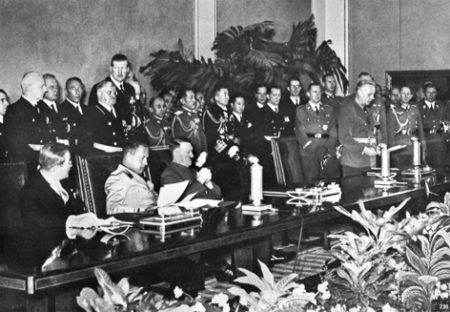
FDR knew this was a game changer and while it didn’t mention the United States, the president fully recognized it was directed at America eventually coming into direct conflict with the Axis powers. This situation required FDR and his senior administration and military staffs to reassess the global situation and devise an initial strategy for an event of war with one or all the treaty members.
This assessment (and recommendation) was written in late October 1940 and presented to the president on 12 November. The twenty-six page document became known as “The Plan Dog” memorandum.
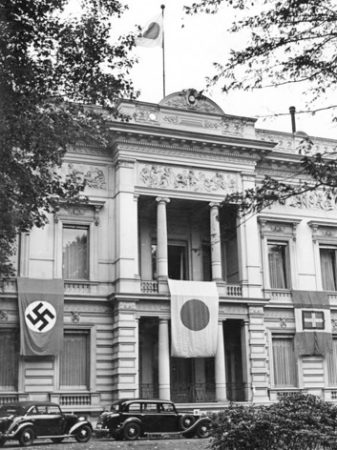
MEDIEVAL PARIS – Volume One & Volume Two
Let us take you on a visit to the Paris of the Middle Ages. Come walk in the footsteps of the men, women, and children who lived, worked, and played in medieval Paris. Stop and see the only three residences still existing from medieval Paris. Learn about the scandalous Nesle Affair. Many of the stops are sites that most tourists don’t know even exist.
Did You Know?
Did you know there is a maze of tunnels underneath London that were used by British-led Special Operations Executive (SOE) during World War II? The tunnels were created in 1941 and 1942 as underground shelters from German bombs during the “The London Blitz.” The tunnels were completed after the worst bombings ended and an innocuous government agency, Inter-Services Research Bureau (ISRB), began using them. This agency was in fact a cover for the SOE.
An Australian businessman has agreed to purchase the tunnels from Britain’s former state telecom monopoly, BT Group Plc. BT operated the Kingsway Telephone Exchange in the 8,000 square meters (86,111 square feet) of tunnels some forty meters (131 feet) below a complex of lawyers’ offices in London’s Holborn district. The new owner intends to renovate the tunnels for preservation purposes as well as commercial retail space.
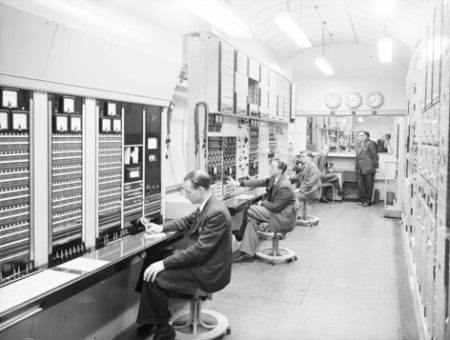
It was here between January 1944 and May 1945 that the SOE set up their department to invent, build, and test eccentric weapons. It was almost like out of a James Bond movie with “Q Branch.” (Click here to read the blog, Explosive Rats.) SOE’s equipment was removed at the end of the war and the tunnels were used as storage for sensitive documents. Eventually, they were sold to BT but became obsolete after the phone company was privatized in the 1990s.
American Isolationism
After George Washington admonished the United States in his farewell address to stay clear of making alliances with European countries, America maintained a strict neutrality policy. Historically, it seemed Europe was constantly at war and Washington knew it would be a folly for America to involve itself in European conflicts. Up until World War I, the neutrality policy seemed to work well.
With Hitler’s rise to power in the 1930s, Japanese aggression in its sphere of influence, and the strong possibility of Italy joining the German dictator in the quest for European domination, Roosevelt and his senior advisors knew the U.S. would eventually be caught up in overseas conflict.
Once World War I ended, Americans retreated into their isolationist cocoon. The isolationist movement was a very strong one and politicians, including Roosevelt, knew that being on the wrong side would cost them their political careers. Balancing a seemingly neutral position while assisting the British was one of FDR’s biggest headaches in his second term leading up to his re-election for a third term in 1940.
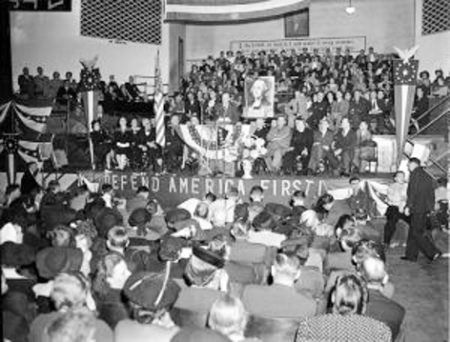
However, military planners weren’t politicians running for re-election every two, four, or six years. Part of their job was to prepare contingency plans for every possibility. By the mid-1930s, it wasn’t hard to predict where the world was headed.
Rainbow Plans
During the interwar period (i.e., between the first and second world wars), senior U.S. military officers in 1924 developed the “Color-coded War Plans.” These were contingency plans for war against various countries. The Joint Basic War Plan – Orange, or the “Orange” plan was the most elaborate and outlined strategies to be used against Japan. (The Black plan was the blueprint for going to war against Germany.) The primary problem was the color-coded plans were based on going to war against only one adversary on one front.
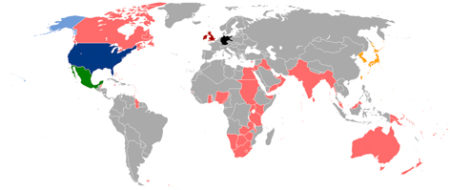
During the mid- to late-1930s, several events (e.g., second Sino-Japanese War and the Molotov-Ribbentrop Pact) took place that convinced strategic planners the “Orange” plan was obsolete. So, five “Rainbow” plans were drawn up based on waging war against multiple enemies. It also discussed wars on different hemispheres. The “Plan Dog” memorandum was heavily influenced by the “Rainbow” plan.
Let’s Meet Harold Raynsford Stark
Adm. Harold Raynsford Stark (1880−1972) served as the eighth Chief of Naval Operations between 1 August 1939 and 26 March 1942. He graduated from the U.S. Naval Academy in 1903, served in World War I and during the interwar years, rose to the rank of vice admiral. One month before the second world war began in early September 1939, Stark became chief of naval operations with the rank of full admiral.
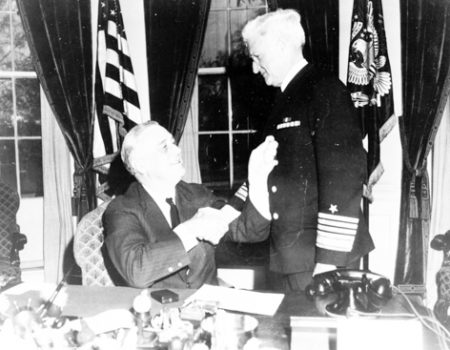
Adm. Stark was a good friend of President Roosevelt and very well respected within the navy as well as political circles. When FDR decided to have a situational analysis for war against the Axis powers drawn up, the responsibility was given to Stark. He and his team produced the memorandum in ten days.
Plan Dog
Stark’s written analysis became known as the “Plan Dog” memorandum ⏤ “Dog” was army and navy lingo for “D” in the phonetic alphabet. The foundation that “Plan Dog” was built on consisted of four assumptions. First and foremost, it was premised on a statement of national interests. The preservation of American freedom from invasion, access to trading partners, and a democratic system of governance completed the basis for the plan.
The analysis suggested the best way to protect U.S. interests was to align itself with Great Britain. (Stark did not believe England could survive a war against Germany.) Second, in the case of multiple fronts, the war on Germany should be given top priority with land offensives in Europe as the only possible way to win (as opposed to giving priority to aerial bombing). After the defeat of Germany, Japan would become the primary target. One of the plan’s “loudest” statements was confirming the need for Britain’s survival and an Anglo-American partnership to fight the totalitarian regimes. (Eighty years later, this may sound like a “no brainer” conclusion but back then, it was a sharp departure from conventional analysis in which a great percentage of the U.S. population remained isolationist and a common belief that England would not survive the war.)
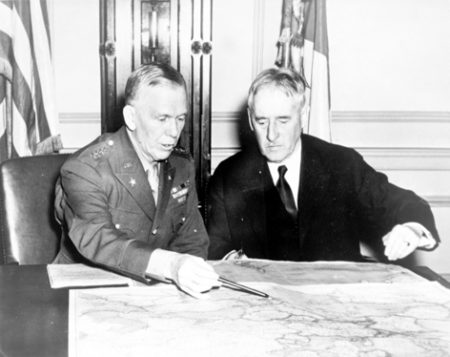
Gen. George C. Marshall (1880−1959) was Army Chief of Staff at the time FDR ordered the analysis. Marshall was well-respected on both sides of the political aisle and a confidant of the president and his secretary of war, Henry Stimson (1867−1950) with whom the general developed a very strong working relationship. Gen. Marshall agreed with almost everything the plan postulated including confirming his long-standing opinion that war strategy should be based on “Germany first,” or “Europe first.” This was the fundamental basis from which Marshall and the Americans continuously argued war strategy with Churchill and his generals.
Plan Dog Alternative Scenarios
The war plan suggested five possible scenarios.
A ⏤ War with Japan in which (America) would have no allies.
B ⏤ War with Japan in which (America) would have the British Empire and Netherlands East Indies as allies.
C ⏤ War with Japan in which she is aided by Germany and Italy, and in which (America) is not aided by allies.
D ⏤ War with Germany and Italy in which Japan would not be initially involved, and (America) would be allied with the British.
E ⏤ (America) would consider the alternative of now remaining out of war and devoting (itself) exclusively to building up our defense of the Western Hemisphere.
Adm. Stark submitted his memorandum to the president with the recommendation that option D be adopted as the country’s strategy once hostilities commenced. However, until war was declared, Stark recommended that option E be followed with a focus on rapidly increasing America’s military strength.
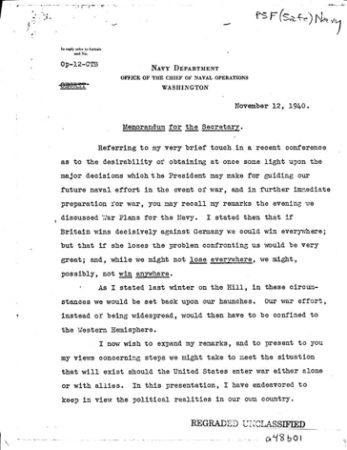
www.fdrlibrary.marist.edu. http://docs.fdrlibrary.marist.edu/psf/box4/a48b01.html
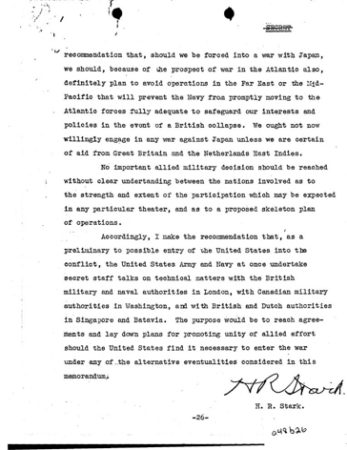
www.fdrlibrary.marist.edu
http://docs.fdrlibrary.marist.edu/psf/box4/a48b01.html
Although FDR never formally endorsed “Plan Dog,” he was fully supportive. (One of Roosevelt’s traits was to always keep his options open and not commit to anything.) Marshall and Stimson embraced the plan and began the campaign to increase the size of the army and navy. FDR adhered to his strategy of “short of war” and continued American aid to England in the form of Lend-Lease. However, he did authorize senior level discussions with the British concerning “Plan Dog.” A year before Pearl Harbor, the “900-pound elephant” in the Oval Office was the unspoken knowledge that any successful war against the Axis powers would have to be fought with the participation of the United States.
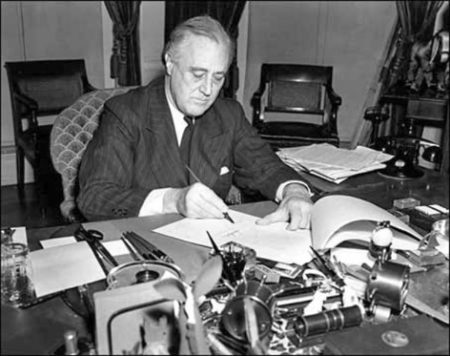
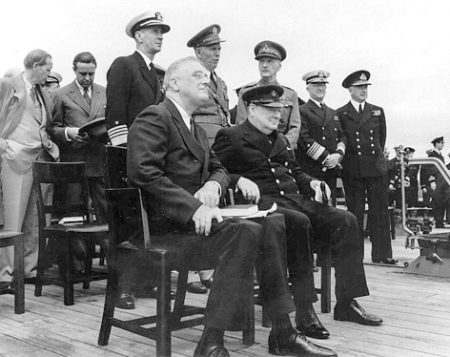
On 7 December 1941 with the attack on Pearl Harbor by Japanese forces, American isolationism ended. The following day, the United States Congress declared war on Japan followed three days later with the declaration of war against Germany and Italy. The “Plan Dog” memorandum fulfilled its duty and provided a road map for conducting the war.
Next Blog: “The de Facto Traitor”
Correspondence and Commentary Policy
We welcome everyone to contact us either directly or through the individual blogs. Sandy and I review every piece of correspondence before it is approved to be published on the blog site. Our policy is to accept and publish comments that do not project hate, political, religious stances, or an attempt to solicit business (yeah, believe it or not, we do get that kind of stuff). Like many bloggers, we receive quite a bit of what is considered “Spam.” Those e-mails are immediately rejected without discussion.
Our blogs are written to inform our readers about history. We want to ensure discussions are kept within the boundary of historical facts and context without personal bias or prejudice.
We average about one e-mail every two days from our readers. We appreciate all communication because in many cases, it has led to friendships around the world.
★ Read and Learn More About Today’s Topic ★
Digitized Copy of the “Plan Dog” Memorandum. Click here to read.
Heinrichs, Waldo. Threshold of War: Franklin D. Roosevelt & American Entry Into World War II. Oxford, U.K.: Oxford University Press, 1990.
Roll, David L. George Marshall: Defender of the Republic. New York: Dutton Caliber, 2019.
Seal, Thomas and Damian Shepherd. Secret ‘James Bond’ Tunnels May Become a Tourist Attraction. Bloomberg News. 25 September 2023. Click here to read the article.
Disclaimer:
There may be a chance that after we publish this particular blog, the video links associated with the blog are no longer accessible. We have no control over this. Many times, whoever posts the video has done so without the consent of the video’s owner. In some cases, it is likely that the content is deemed unsuitable by YouTube. We apologize if you have tried to access the link and you don’t get the expected results. Same goes for internet links.
What’s New With Sandy and Stew?
We don’t know what you are up to right now but for us, it is tax season. I have responsibility for three tax returns and that can put a big dent in your schedule. Additionally, we have decided to tackle the annual spring cleaning a little earlier this year since we’ll be traveling for most of April (Japan) and May (Baltic). This year’s spring cleaning takes the form of (a) going through my father’s memorabilia and trying to figure out who gets what; (b) the on-going push to go through thousands of family photos with the goal of distribution; and (c) other stuff that you’re really not interested in.
Thank you to all of you who subscribe to our blogs. It seems there isn’t a day that goes by where we don’t increase our readership. Please let your history buff friends and family members know about our blog site and blogs.
Someone Is Commenting On Our Blogs
Thanks to Raymond K. for letting us know several of our image captions on the blog, Meyer’s Bugle (click here to read the blog), were incorrect. We’ve updated the images to reflect the correct information. I greatly appreciate it when our readers like Raymond contact us and point out errors whether it’s in the blog content or image captions.
If there is a topic you’d like to see a blog written about, please don’t hesitate to contact me. I love hearing from you so keep those comments coming.
Shepherd.com is like wandering the aisles of your favorite bookstore.
Do you enjoy reading? Do you have a hard time finding the right book in the genre you enjoy? Well, Ben at Shepherd.com has come up with an amazing way to find that book.
Shepherd highlights an author (like me) and one of their books. The author is required to review five books in the same genre. So, if a reader is interested say in cooking, they can drill down and find specific books about cooking that have been reviewed by authors in that category. Very simple.
If you like to read, I highly recommend you visit Shepherd.com. If you do, please let me know what you think and I will forward Ben any suggestions or comments you might have.
Click here to visit Shepherd’s website.
Click the books to visit Stew’s bookshelf.
Check out Stew’s new bookshelf on the French Revolution.
Share This:
Follow Stew:
Find Stew’s books on Amazon and Apple Books.
Please contact Stew directly for purchase of books, Kindle available on Amazon. Stew.ross@Yooperpublications.com or Contact Stew on the Home Page.
Please note that we do not and will not take compensation from individuals or companies mentioned or promoted in the blogs.
 Walks Through History
Walks Through History
Copyright © 2024 Stew Ross









